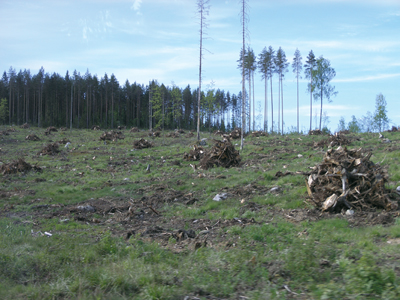
Sustainable Biomass: How much is enough?
May 27, 2009
By Evelyne Thiffault
The forest bioenergy sector is developing rapidly across Canada, and great efforts are being devoted to the development of new technologies for converting forest biomass to energy.
The forest bioenergy sector is developing rapidly across Canada, and great efforts are being devoted to the development of new technologies for converting forest biomass to energy. Wood waste from industrial processing is currently the major feedstock, but consideration is increasingly being given to harvesting slash. This “waste” is currently either piled at roadside in the case of whole-tree harvesting, or left in the stand in cut-to-length (CTL or stem-only) operations.
 |
|
| Is this too much? A forest in southern Finland picked clean, stumps and all. How much to remove, and where is the topic of this regular column.
|
The harvest waste is a low-hanging fruit for the bioenergy sector, since it does not compete with existing industries. However, while we are getting better every day at the economics and the engineering of taking out the slash, as seen for example with Cyclofor in the last Canadian Biomass issue, it is relevant, and not just for (potentially) obnoxious forest ecologists like myself, to wonder whether increased extraction of biomass from the forest is ecologically sustainable. This “‘waste” may in fact play a crucial role for the functioning of the forest ecosystem.
Bad news first
Historically, stem-only harvesting was typical in much of Canada, with trees manually felled, the stem delimbed where it fell, and branches and tops left behind. The stem was then hauled to the roadside using horses or oxen. The introduction of line skidders in the 1960s increased harvest productivity because stems could be hauled more efficiently. In the 1970s and 1980s, however, safety issues related to manual delimbing and a shortage of forest workers forced many forest companies to move to whole-tree harvesting. This was done by mechanizing delimbing using a slasher at the roadside. Although the more recent introduction of harvesters with efficient harvesting heads to delimb, buck and sort on site, as well as the use of forwarders, has increased the popularity of CTL operations in the 1990s, whole-tree harvesting remains the most common practice in large parts of Canada, and one that may expand with the development of a market for slash.
Given the length of forest rotations under Canadian climatic conditions, whole tree removal is still fairly new. We may not have observed the full consequences of this practice on forest productivity yet. So, while this may sound overly dramatic, we may have caused unintended negative impacts on the functioning of the ecosystem, impacts that will appear before our eyes only in upcoming decades. Or maybe not. Still, here it is worth recalling that the whole idea of forest biomass for bioenergy being “carbon-neutral”, as opposed to fossil fuels, assumes that the harvested stands will actually grow back and be as well-stocked and productive as they were before harvesting. If there’s a risk that increased biomass removal damages the ecosystem and hinders tree growth and carbon sequestration in future rotations, biomass utilization may not be so ‘neutral’ after all.
Now the good news
In Canada, concerns about the sustainability of intensive biomass removal were first voiced in the 1970s, when the oil crisis pushed prices of fossil fuels to record levels, and alternative sources of energy such as harvest slash were considered. Some studies were launched to investigate the impact of slash removal, and the Canadian Forest Service financed over many years the Energy from the Forest program (ENFOR), a part of which was aimed at developing tools to define sustainable levels of organic matter and nutrient removal. So we already have a moderately abundant ecological knowledge, from our Canadian research base and also from research done in countries with similar forest and climatic conditions. We know that in most cases, whole-tree harvesting slightly acidifies the soil and reduces soil nutrient reserves, especially calcium. We also know that for some site conditions and some tree species, it reduces tree productivity.
Why is this good news? By knowing which sites and species are sensitive to intensive biomass removal, we can avoid it in these areas. At the same time we can be a little more confident that this practice is probably sustainable for the remaining sites and species.
Of course, scientific knowledge is still incomplete. But the other good news is that the Canadian bioenergy sector is still nascent; although whole-tree harvesting is common, we are not yet intentionally chasing every twig and branch on a large scale in our forest to feed this industry. There is thus plenty of space to develop our understanding of ecological impacts, for example by establishing legacy field trials comparing the effects of different intensities of biomass removal on various ecosystem processes over different sites. This information can then be used to adjust the list of ‘no-go’ sites as new data accumulate. This way the expansion of our bioenergy industry can be tailored to fit the ecological sustainability of forest ecosystems, always to the best of our knowledge.
Stay tuned…
Of course, this is all easier said then done. But as they say, knowledge is power. That’s why in future columns we will discuss various issues related to the sustainability of forest biomass harvesting, and also have a look of what’s being done in other countries to tackle these issues. This will hopefully help draw the lines in grey areas, despite the uncertainties.
Evelyne Thiffault of Natural Resources Canada writes this regular column on the sustainability of biomass harvesting for Canadian Biomass on behalf of the Canadian Research Group on Ecosystem Sustainability.
Print this page